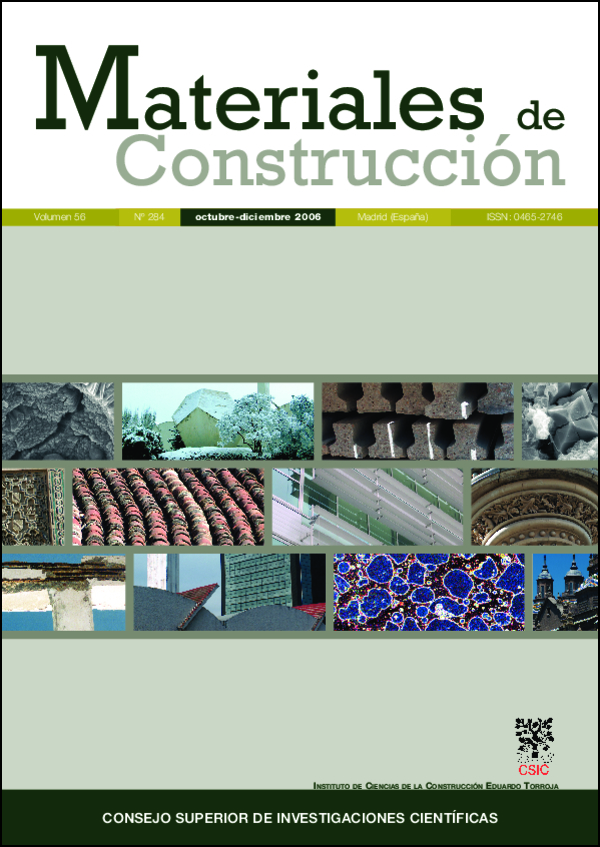Technical Note: Alterations in the stone masonry of the Capitol Room of Sevilla City Hall
DOI:
https://doi.org/10.3989/mc.2006.v56.i284.21Keywords:
stone masonry, coverings, hygrothermal conditions, damagesAbstract
The main aim of this work has been to determine the causes of stone loss (small particles and one larger piece) and mortar loss in the coffered vault of the Capitol Room in the City Hall of Seville. The analyses and assays carried out during the course of this research have revealed that this masonry comprises a covering of oil paints over mortar-stucco of calcite, quartz, gypsum,and lead white with linseed oil when the walls were not covered. In addition, it was confirmed that the installation of air-conditioning caused a change in the humidity and temperature in the vault, aggravated by the elimination of the cross-ventilation that the structure had since it was built. The combination of these two circumstances likely triggered the pathology in the masonry.
Downloads
References
(1) Monjo Carrió, J. et al.: Patología y técnicas de intervención fachadas y cubiertas. Ed. Murilla-Leria, 1999.
(2) Gestoso y Pérez, J.: Sevilla monumental y artística. 3 Volúmenes, 1889-1892.
(3) Morales Alfredo, J.: El Ayuntamiento de Sevilla. Arquitectura y Simbología, Sevilla, 1981.
(4) Martín Pérez, A.: Ensayos y experiencia de alteración en la conservación de obras de piedra de interés histórico artístico, Fundación Ramón Areces, 1990.
(5) Lubelli, Barbara; Van Hees, Rob P. J.; Groot, Caspar W. P.: Investigation on the behaviour of a restoration plaster aplied on heavy salt loaded masonry, Construction and Building Materials, 20 (2006), pp. 691-699. doi:10.1016/j.conbuildmat.2005.02.010
(6) Blanco Varela, M. T. et al.: “Los revocos de Medina Azahara. Parte 1: Caracterización del material y procesos de alteración”, Materiales de Construcción, nº 245 (1997).
(7) Pérez Bernal, J. L.; Bello López, M. A.: Dióxido de azufre. Química atmosférica y destrucción del Patrimonio, Fundación El Monte, 2004.
(8) AA. VV.: Técnicas de diagnóstico aplicadas a la conservación de los materiales de construcción en los edificios históricos, Junta de Andalucía, IAPH, 1996.
(9) González, V. et al.: Análisis y ensayos a piedras y morteros, Vorsevi, 2005.
(10) Hardy, R.; Tucker, M.: “X-Ray powder diffraction of sediments” en Techniques in sedimentology. Scientific Publications, 1989.
(11) Parra, E.: Análisis y ensayos a pátinas, Universidad Alfonso X el Sabio, 2005.
(12) Álvarez de Buergo, M.; Fort, R.: “Protective patinas applied on stony façades of historical buildings in the past”, Construction and Building Materials, 17 (2003), pp. 83-89. doi:10.1016/S0950-0618(02)00107-1
(13) Palomo, A. et al.: “Pinturas rupestres de la cueva de La Graja. Caracterización de pigmentos y análisis digital de imágenes”, Materiales de Construcción, nº 273 (2004).
Downloads
Published
How to Cite
Issue
Section
License
Copyright (c) 2006 Consejo Superior de Investigaciones Científicas (CSIC)

This work is licensed under a Creative Commons Attribution 4.0 International License.
© CSIC. Manuscripts published in both the print and online versions of this journal are the property of the Consejo Superior de Investigaciones Científicas, and quoting this source is a requirement for any partial or full reproduction.
All contents of this electronic edition, except where otherwise noted, are distributed under a Creative Commons Attribution 4.0 International (CC BY 4.0) licence. You may read the basic information and the legal text of the licence. The indication of the CC BY 4.0 licence must be expressly stated in this way when necessary.
Self-archiving in repositories, personal webpages or similar, of any version other than the final version of the work produced by the publisher, is not allowed.
















